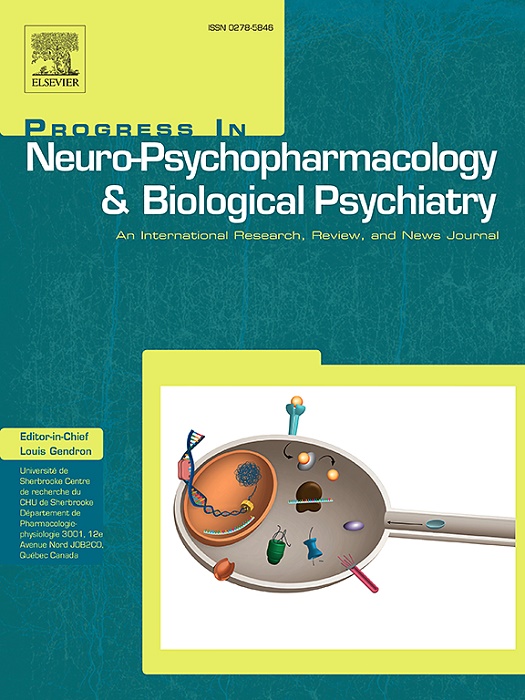Inter-subject functional variability of gray and white matter in autism spectrum disorder
IF 3.9
2区 医学
Q1 CLINICAL NEUROLOGY
Progress in Neuro-Psychopharmacology & Biological Psychiatry
Pub Date : 2025-09-16
DOI:10.1016/j.pnpbp.2025.111500
引用次数: 0
Abstract
Background
Autism spectrum disorder (ASD) is biologically highly heterogeneous; however, most studies focused on group-level analyses, overlooking inter-subject variability in functional connectivity (IVFC), particularly in white matter IVFC (WM-IVFC) where mechanisms and genetic influences remain unclear.
Methods
Resting-state functional magnetic resonance imaging data from 272 patients with ASD and 368 typical controls (TC) were obtained from the Autism Brain Imaging Data Exchange Project (ABIDE II) database. Gray matter IVFC (GM-IVFC) and WM-IVFC were compared between groups and correlated with symptom severity. A support vector machine (SVM) model was constructed to assess the diagnostic potential of GM-IVFC, WM-IVFC, and their combination. Transcriptome neuroimaging analyses were conducted by correlating IVFC alterations with regional gene expression data from the Allen Human Brain Atlas.
Results
Both GM-IVFC and WM-IVFC showed regionally uneven distributions across the brain. Compared to TC, patients with ASD exhibited increased GM-IVFC mainly in the default mode and attention networks, and altered WM-IVFC mainly in the genu of the corpus callosum and superior fronto-occipital fasciculus, which were significantly associated with symptom severity. The SVM model utilizing both the GM-IVFC and WM-IVFC features yielded the best diagnostic performance (accuracy = 0.77). Transcriptome-neuroimaging associations revealed that GM-IVFC alterations were enriched in genes involved in sensory organ morphogenesis, whereas WM-IVFC alterations were linked to astrocyte-related pathways.
Conclusions
Our findings highlight the complementary roles of GM-IVFC and WM-IVFC, supporting their potential as biomarkers and offering novel insights into the genetic and neurobiological underpinnings of ASD.
自闭症谱系障碍中灰质和白质的主体间功能变异。
背景:自闭症谱系障碍(ASD)在生物学上具有高度异质性;然而,大多数研究侧重于群体水平的分析,忽视了功能连接(IVFC)的主体间变异性,特别是白质IVFC (WM-IVFC),其机制和遗传影响尚不清楚。方法:从自闭症脑成像数据交换项目(ABIDE II)数据库中获取272例ASD患者和368例典型对照(TC)的静息状态fMRI数据。灰质IVFC (GM-IVFC)和WM-IVFC组间比较,并与症状严重程度相关。构建支持向量机(SVM)模型,评估GM-IVFC、WM-IVFC及其组合的诊断潜力。通过将IVFC改变与Allen人脑图谱的区域基因表达数据相关联,进行转录组神经成像分析。结果:GM-IVFC和WM-IVFC在脑内的区域分布均不均匀。与TC相比,ASD患者GM-IVFC增加主要表现在默认模式和注意网络,WM-IVFC改变主要表现在胼胝体膝部和额枕上束,这与症状严重程度显著相关。同时利用GM-IVFC和WM-IVFC特征的SVM模型诊断效果最好(准确率 = 0.77)。转录组-神经影像学关联显示,GM-IVFC的改变丰富了与感觉器官形态发生有关的基因,而WM-IVFC的改变与星形胶质细胞相关的途径有关。结论:我们的研究结果强调了GM-IVFC和WM-IVFC的互补作用,支持它们作为生物标志物的潜力,并为ASD的遗传和神经生物学基础提供了新的见解。
本文章由计算机程序翻译,如有差异,请以英文原文为准。
求助全文
约1分钟内获得全文
求助全文
来源期刊
CiteScore
12.00
自引率
1.80%
发文量
153
审稿时长
56 days
期刊介绍:
Progress in Neuro-Psychopharmacology & Biological Psychiatry is an international and multidisciplinary journal which aims to ensure the rapid publication of authoritative reviews and research papers dealing with experimental and clinical aspects of neuro-psychopharmacology and biological psychiatry. Issues of the journal are regularly devoted wholly in or in part to a topical subject.
Progress in Neuro-Psychopharmacology & Biological Psychiatry does not publish work on the actions of biological extracts unless the pharmacological active molecular substrate and/or specific receptor binding properties of the extract compounds are elucidated.

 求助内容:
求助内容: 应助结果提醒方式:
应助结果提醒方式:


